
The Norton Motorcycle Company is a brand of motorcycles, originally based in Birmingham, England. This company is owned by Indian multinational giant TVS Motor Company. For some years around 1990, the rights to use the name on motorcycles was owned by North American financiers. From 2008 to 2020, a line of motorcycles was produced under owner and chief executive Stuart Garner. Due to financial failure with large debts, in April 2020 administrators BDO agreed to sell certain aspects of Garner's business to Project 303 Bidco Limited, a new business established for the purpose with links to Indian motorcycle producer TVS Motor Company.

The BSA Bantam is a two-stroke unit construction motorcycle that was produced by the Birmingham Small Arms Company (BSA) from 1948 until 1971. Exact production figures are unknown, but it was over 250,000 and some estimates place the number closer to half a million.

The Triumph Trident and BSA Rocket 3 was a technically advanced, high-performance roadster motorcycle made by Triumph Engineering and BSA from 1968 to 1975, and sold under both the Triumph and BSA marques. Alongside the Honda CB750, and later the Kawasaki triples, it brought a new level of sophistication to street motorcycles, marking the beginning of the superbike era. The Honda CB750 overshadowed the Trident to be remembered as the 'first superbike', in spite of the Triumph Trident actually debuting before the Honda by a few weeks.

The BSA Gold Star is a motorcycle made by BSA from 1938 to 1963. They were 350 cc and 500 cc single-cylinder four-stroke production motorcycles known for being among the fastest bikes of the 1950s. Being hand built and with many optional performance modifications available, each motorcycle came from the factory with documented dynamometer test results, allowing the new owner to see the horsepower (bhp) produced.

Edward Turner was an English motorcycle designer. He was born in Camberwell in the London Borough of Southwark, on the day King Edward VII was proclaimed King. In 1915, Turner had his first ride on a motorcycle, a Light Tourist New Imperial.

The BSA B31 is a motorcycle that was produced by Birmingham Small Arms Company.

The BSA Golden Flash, commonly referred to as the Gold Flash, was a 646 cc (39.4 cu in) air-cooled parallel twin motorcycle designed by Bert Hopwood and produced by Birmingham Small Arms Company (BSA) at Small Heath, Birmingham. The Golden Flash was the first model in the BSA A10 series. It was available in black and chrome; but it was the distinctive golden paint scheme that gave The Golden Flash its name. Production continued until 1963, when it was superseded by the BSA A65 Star.

The Velocette MAC is a British motorcycle made by Velocette. A reliable single-cylinder, the MAC coped well with the low-grade post war petrol and was a popular commuter and touring motorcycle. Although they started as innovators, Velocette failed to keep pace with developing technology and production ended in 1959.

The Norton International or Cammy Norton is a Norton Motors Ltd overhead cam (OHC) motorcycle built between 1931 and 1957.

The BSA M20 was a British motorcycle made by Birmingham Small Arms Company (BSA) at their factory in Small Heath, Birmingham. Although initially viewed as a near failure by the War Office in 1936, the M20 evolved into one of the longest serving motorcycles in the history of British military motorcycling, as well as becoming the most numerous type produced for World War II with 126,000 in active service. Many are still in use around the world today.
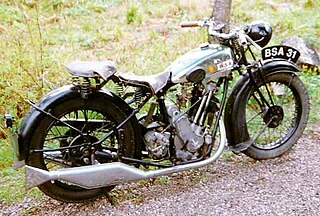
The BSA S-Series of motorcycles, most commonly known as the BSA Sloper, were a series of motorcycles produced by the Birmingham Small Arms Company (BSA) from 1927 to 1935.

The BSA A7 was a 500cc motorcycle model range made by Birmingham Small Arms Company (BSA) at their factory in Armoury Road, Small Heath, Birmingham. The range was launched in 1946 using a 495 cc (30.2 cu in) long stroke engine. An improved 497 cc (30.3 cu in) version based on the BSA A10 engine was launched in 1950. The various A7 models continued in production with minor modifications until 1961/2 when they were superseded by the unit-construction A50 model.

The Indian Scout is a motorcycle built by the Indian Motocycle Company from 1920 to 1949. It rivaled the Chief as Indian's most important model. The 101 Scout, made from 1928 to 1931, has been called the best motorcycle Indian ever made. A second line of Scouts, with heavier frames, was introduced in 1932 alongside the Standard Scout, which replaced the 101 Scout and shared its frame with the Chief and the Four. The small-displacement Scout and the Sport Scout, introduced in 1934, were continued until the end of civilian production in 1942. Military versions of both models were used by US and other Allied forces during World War II.

The BSA C15 was a 250 cc single-cylinder ohv motorcycle manufactured by the British company BSA from September 1958 until 1967, and was BSA's first four-stroke unit-construction bike. For most of that period, after the introduction of 'Learner Laws' in 1961, a 250 cc was the largest capacity solo machine that a learner could ride unaccompanied when displaying L-plates in the United Kingdom. A road-going Sports derivative was added in 1961, and off-road versions, for Trials and Scrambles, were also available in the range.
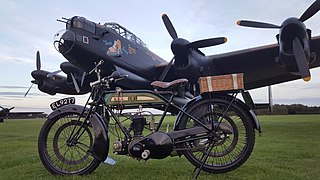
The BSA Model L is a British motorcycle manufactured by Birmingham Small Arms Company (BSA) at their factory in Armoury Road, Small Heath, Birmingham from 1923/1924.

BSA motorcycles were made by the Birmingham Small Arms Company Limited (BSA), which was a major British industrial combine, a group of businesses manufacturing military and sporting firearms; bicycles; motorcycles; cars; buses and bodies; steel; iron castings; hand, power, and machine tools; coal cleaning and handling plants; sintered metals; and hard chrome process.
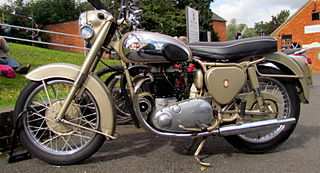
The BSA A10 series was a range of 646 cc (39.4 cu in) air-cooled parallel twin motorcycles designed by Bert Hopwood and produced by Birmingham Small Arms Company at Small Heath, Birmingham from 1950 to 1963. The series was succeeded by the A65 unit construction models.

The BSA B25 was a series of 250 cc (15 cu in) unit construction single-cylinder OHV four-stroke motorcycles made by the Birmingham Small Arms Company. Developed from the BSA C15, the machines were produced between 1967 and 1971. The B25 was the fastest British production 250.
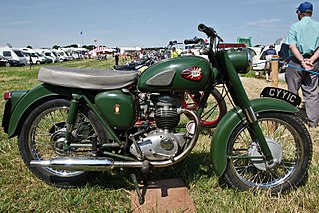
The BSA B40 was a series of 350 cc (21 cu in) unit construction single-cylinder OHV four-stroke motorcycles made by the Birmingham Small Arms Company. Developed from the BSA C15, the machines were produced between 1961 and 1967 for civilian use. Military versions were manufactured from 1967 to 1970. Around 14,000 machines were built in total.
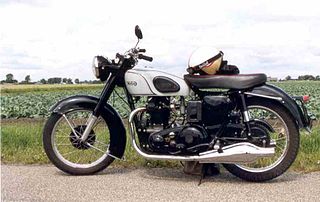
The Norton Model 7 Dominator was a 500 cc vertical twin motorcycle manufactured by the Norton Motorcycle Company from 1949 to 1955. It was the first of Norton's Dominator range of motorcycles. The engine was designed by Bert Hopwood and was a departure from Norton's previous practice of producing single-cylinder machines. The Model 7 was used in Japan as a police motorcycle.





















